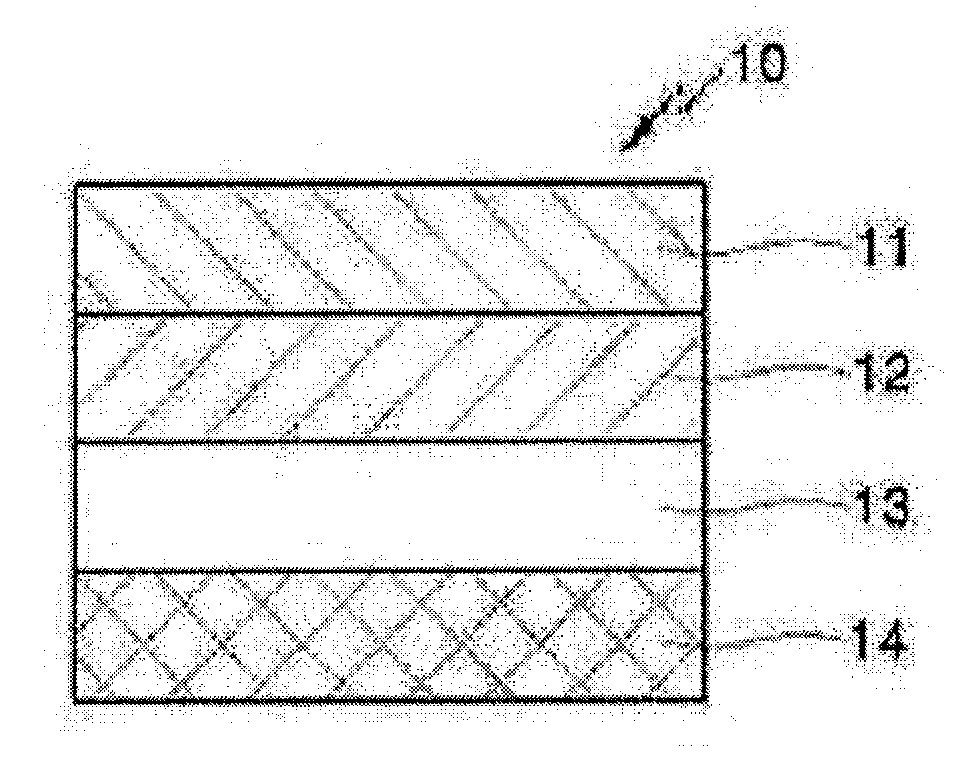Dye for dye-sensitized solar cell and Solar cell using it
a solar cell and dye sensitization technology, applied in the direction of solid-state devices, electrolytic capacitors, chemistry apparatus and processes, etc., can solve the problems of troublesome practical use, high cost of solar cells, and low efficiency of solar cells, and achieve high stability in electrolyte and semiconductor oxid
- Summary
- Abstract
- Description
- Claims
- Application Information
AI Technical Summary
Benefits of technology
Problems solved by technology
Method used
Image
Examples
example 1
Synthesis of cis-bis(isothiocyanato)bis(2,2′-bipyridyl-4,4′-dicarboxylato)-ruthenium(II) bis(2,2′-pyridyl-4,4′-dicarboxylic acid dihexadecylester as a dye of the dye-sensitized solar cell
(1) Synthesis of 2,2′-bipyridyl-4,4′-dicarboxylic acid dihexadecylester
[0096]
[0097]In three neck flask, 5 ml of 2,2′-bipyridyl-4,4′-carboxylic acid and thionylchloride were reacted for 3 hrs at 75˜85° C. to abstain a yellow crystal. The remained thionylchloride was evaporated under vacuum.
[0098]The yellow crystal was added with 30 ml of benzene, and further added with an excess of 1-hexanol (20.5 mmol). This mixture was reacted at 75˜85° C. for 2 hrs, and then added with 30 ml of chloroform and followed by neutralizing with 0˜4° C. of cold water-solution of sodium bicarbonate.
[0099]The lower layer was separated by a separatory funnel, and recrystallized with acetone and chloroform to abstain a colorless crystal of 2,2′-bipyridyl-4,4′-dicarboxylic acid dihexadecylester.
(2) Synthesis cis-bis(isothiocy...
example 2
Synthesis of cis-bis(isothiocyanato)bis(2,2′-bipyridyl-4,4′-dicarboxylato)-ruthenium(Mbis(2,2′-pyridyl-4,4′-dicarboxylic acid dioctyl ester as a dye of the dye-sensitized solar cell
(1) Synthesis of 2,2′-bipyridyl-4,4′-dicarboxylic acid dihexadecylester
[0107]
[0108]In three neck flask, 5 ml of 2,2′-bipyridyl-4,4′-carboxylic acid and thionylchloride were reflux-heated for 3 hrs at 75˜85° C. to abstain a yellow crystal. The remained thionylchloride was evaporated under vacuum.
[0109]The yellow crystal was added with 30 ml of benzene, and further added with an excess of 1-octanol (20.5 mmol), and followed by reflux-heating at 75˜85° C. for 3 hrs. 30 ml of chloroform was added thereto and followed by neutralizing with 0˜4° C. of cold water-solution of sodium bicarbonate.
[0110]The lower layer was separated by a separatory funnel and recrystallized with acetone and chloroform to abstain a colorless crystal of 2,2′-bipyridyl-4,4′-dicarboxylic acid dioctylester.
(2) Synthesis of cis-bis(isothio...
example 3
Manufacturing of the Dye-Sensitized Solar Cell
[0119]A transparent conductor of indium-doped tin oxide is coated with a dispersion solution comprising titanium oxide particles on area of 1 cm2 using the Doctor Blade method, and performed a thermoplastic process for 30 min to abstain a porous membrane of titanium oxide having a thickness of 18 μm.
[0120]And then, the specimen was kept 80° C. and immersed in 0.3 mM of dye dispersion solution for more than 12 hrs, which the prepared dye was dissolved in ethanol in order to be adhered with the dye.
[0121]The dye-adhered porous membrane of titanium oxide was washed with ethanol, and dried at ambient temperature to manufacture the first electrode formed with a light absorbing layer
[0122]For the second electrode, a transparent conductor of indium-doped tin oxide is deposited with Pt using a sputter to about 200 nm thickness, and drilled to make a micro hole by a driller of 0.75 mm diameter for injecting an electrolyte solution, thereby manufa...
PUM
 Login to View More
Login to View More Abstract
Description
Claims
Application Information
 Login to View More
Login to View More - R&D
- Intellectual Property
- Life Sciences
- Materials
- Tech Scout
- Unparalleled Data Quality
- Higher Quality Content
- 60% Fewer Hallucinations
Browse by: Latest US Patents, China's latest patents, Technical Efficacy Thesaurus, Application Domain, Technology Topic, Popular Technical Reports.
© 2025 PatSnap. All rights reserved.Legal|Privacy policy|Modern Slavery Act Transparency Statement|Sitemap|About US| Contact US: help@patsnap.com



